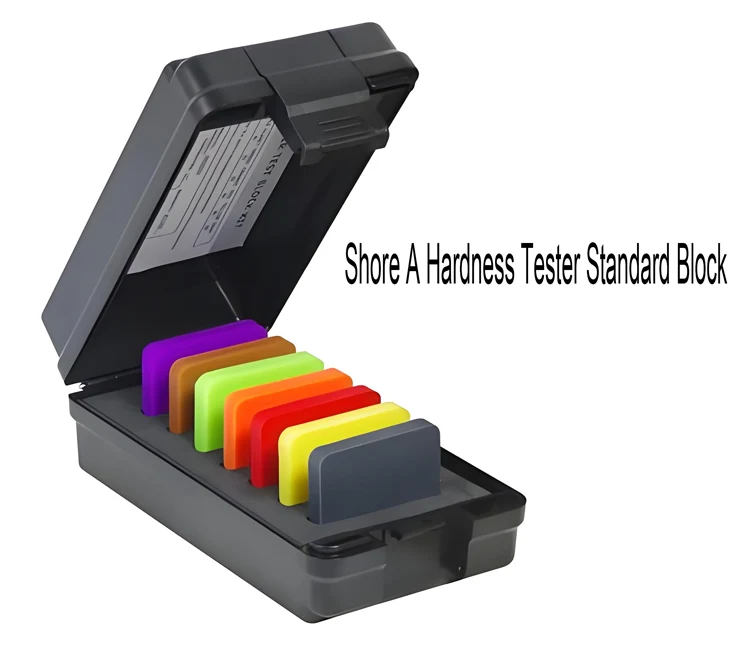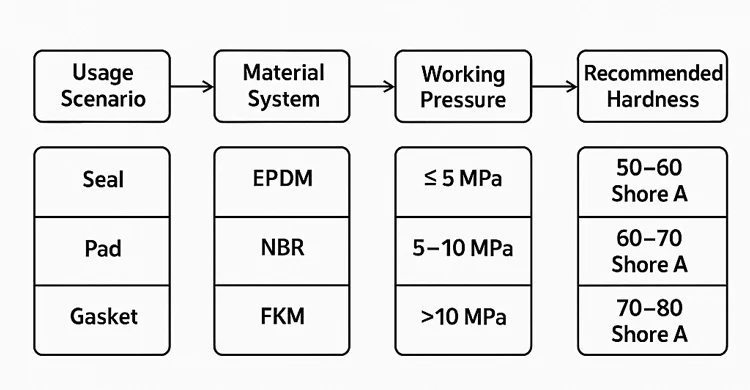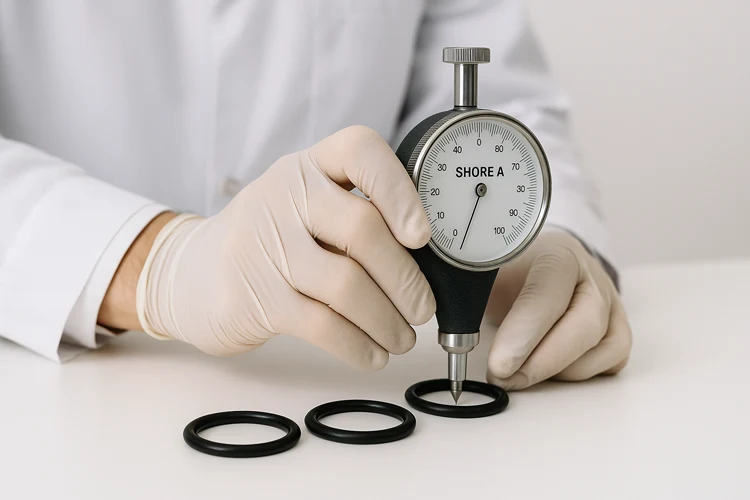I. Why Customers Care So Much About “Hardness”
When it comes to rubber components, hardness is often the first thing your customer asks about—and for good reason. It’s one of the most intuitive yet misunderstood performance parameters. Whether it’s an O-ring, gasket, seal, or bumper, the hardness of rubber is often perceived as a proxy for durability, sealing quality, and ease of installation.
Hardness is the rubber product’s “first impression”—and it directly affects how it performs in real-world conditions.
Let me illustrate this with a real example: One of our clients used a Shore A 50 hardness O-ring in a hydraulic system where pressure spikes were common. After six months, the system started leaking. The post-failure analysis pointed to under-compression and extrusion damage due to insufficient hardness. The result? A total maintenance cost of over $300,000.
Rubber hardness isn’t just a technical spec. It can make or break the functional reliability of your product—and your relationship with your customers.
So how can you choose the right hardness? And how do different hardness levels affect sealing, durability, and even installation ease?
Here’s a complete breakdown of the standards, principles, and real-world strategies I use to get the hardness right, every time.

II. Rubber Hardness Testing Standards and Misconceptions
Understanding how rubber hardness is measured—and the potential pitfalls in the process—is essential for making informed design and sourcing decisions. Not all hardness tests are created equal, and errors in measurement are more common than many realize.
1. Overview of Main Testing Methods: Shore A, Shore D, and IRHD
Rubber hardness is typically quantified using a durometer scale. But which one should you use?
- Shore A: The most widely used scale, ideal for soft to medium-hard elastomers like gaskets, O-rings, and sealing strips. It uses a blunt needle and measures indentation under standardized force.
- Shore D: Designed for harder materials such as thermoplastic elastomers and semi-rigid plastics. It uses a sharper point and greater force.
- IRHD (International Rubber Hardness Degrees): Common in quality control labs, especially in Europe. It offers higher repeatability by applying force in a controlled, time-based manner—excellent for precision components and R&D environments.
Each scale has its specific application context, and mixing them up can lead to serious performance mismatches.
“Using Shore D when the spec calls for Shore A is like weighing yourself in pounds when the doctor needs kilograms—it’s not just wrong, it’s misleading.”
2. Common Errors and Hidden Pitfalls in Testing
Even if you’re using the correct scale, measurement consistency is a hidden trap.
- Sample Thickness: Test pieces thinner than 6mm can yield false readings due to substrate influence.
- Non-standard Setup: Deviating from ISO 48 or DIN 53505 (like not waiting the full dwell time) introduces error.
- Operator Variability: In field measurements, excessive pressure or angle deviation can easily cause ±5 Shore A deviation.
I’ve personally seen the same rubber part tested on three different durometers, with readings ranging from 62 to 68 Shore A—all due to operator handling and machine calibration.
Bottom line: Don’t just “read the number”—question how it was measured.
III. How Hardness Affects Rubber Performance
Hardness isn’t just a number—it’s a powerful predictor of how a rubber component behaves under stress, wear, and environmental exposure. Getting this parameter wrong can mean the difference between flawless performance and premature failure. Let’s break down how different hardness levels impact key performance dimensions.
3.1 Mechanical Properties: Is the Hardness Fit for Purpose?
Sealing Performance and Compression Set
When selecting rubber for sealing, compression behavior is directly linked to hardness:
- For low-pressure static seals, Shore A 50–60 strikes a good balance between flexibility and resilience.
- For high-pressure applications, such as hydraulic fittings, I recommend Shore A ≥70 to prevent extrusion and seal blowout.
Abrasion Resistance
In high-friction environments like pulleys, dampers, or rollers:
- Shore A 75 ±3 often delivers optimal wear resistance without becoming too brittle.
- Go above 85, and you risk crack initiation during flex cycles.
Standard reference: GB/T 9867 confirms that abrasion resistance peaks in the 70–80 Shore A range for most general-purpose rubbers.
3.2 Dynamic Properties: Hardness and Service Life
Fatigue Resistance
Soft rubbers (e.g., Shore A 40) excel in vibration damping and low-cycle fatigue, making them ideal for anti-vibration pads.
Conversely, harder rubbers (Shore A 70) perform better in high-frequency dynamic loads but are prone to microcrack propagation over time.
Rebound and Energy Management
- For applications like bump stops or shock absorbers, high rebound rubber (Shore A 30–40) provides excellent energy return.
- Data from DIN 53512 shows rebound resilience significantly drops as hardness increases, leading to more energy loss and heat buildup.
3.3 Environmental Adaptability: Behavior Under Stress
Thermal Aging
- High-temperature use (≥150°C) causes long-term hardening. I always recommend designing with a 5–10 Shore A buffer to accommodate this shift.
Chemical Resistance
- Certain elastomers (like NBR in oils or EPDM in alkalis) experience hardness drift after prolonged exposure. If not factored in, seals may shrink or swell, causing leaks.
3.4 Human Factors: Usability Isn’t Just Technical
Tactile Feel and Flexibility
- For medical or consumer goods, Shore A <20 delivers the soft, skin-like feel users expect.
- On the other hand, industrial gloves require Shore A >40 for tear and cut resistance.
Ease of Installation
- I’ve seen many O-ring complaints boil down to one cause: rubber that’s simply too hard to stretch or seat without damage. Over-hardening also increases the risk of cracking during press-fit assembly.
Takeaway: Don’t assume harder is better—choose hardness based on what the rubber needs to do, and where.
IV. Hardness Selection Strategies for Common Applications
Selecting the right hardness isn’t guesswork—it’s about matching technical requirements with real-world use cases. In my experience, understanding the pain points of each application scenario can help prevent costly failures and ensure long-term satisfaction.
1. Solutions for 3 Common Industry Problems
① Oil Leakage in Hydraulic Systems
Many failures stem from improper compression. Here’s my go-to rule:
- Use Shore A 70–80 for high-pressure sealing.
- Always cross-reference with compression set resistance. Even a well-fitted O-ring will fail if it takes a permanent set too quickly.
② Noise in Machinery or Equipment
For anti-vibration or acoustic control, hardness affects damping:
- Choose mid-to-low Shore A (40–60) for optimal energy absorption.
- Rubber with high structural damping (like natural rubber or soft EPDM) performs better than harder counterparts in vibration-isolation mounts.
③ Aging or Deformation in Harsh Environments
Hardness degradation is often underestimated. I use aging curve simulations—especially for EPDM and NBR compounds—to predict changes over 3–5 years of service.
Tip: Always check the post-aging Shore A value—not just initial specs.
2. Rubber Hardness Recommendation Table
| Media Type | Pressure Range | Temp Range | Suggested Shore A |
|---|---|---|---|
| Air | <1 MPa | -20°C to 80°C | 55–65 |
| Oil | 2–20 MPa | 0°C to 150°C | 70–80 |
| Water | 1–10 MPa | 0°C to 100°C | 60–70 |
| Acids | <5 MPa | -10°C to 90°C | 65–75 |
Visual Flowchart: From Scenario to Shore A

This approach helps quickly narrow down the correct durometer when developing a new seal, pad, or gasket—especially useful in customer discussions.
“Don’t sell a Shore A 80 just because it sounds strong—sell what fits the application best.”
V. Hardness Control Strategies During Production
Even with the right hardness specified on paper, real-world production can throw curveballs. That’s why I always emphasize tight control over formulation and process variables—both of which significantly affect final rubber hardness.
1. Formulation Adjustments and Hardness Prediction
Rubber compounders know: small changes in filler or crosslinking agent levels can swing Shore A readings dramatically. Here are some field-tested guidelines:
- Carbon black: Adding 10 phr of N330 (a common reinforcing black) increases hardness by about +3 Shore A.
- Silica (white carbon black): Also boosts hardness but with better resilience than carbon black—ideal for high-end elastomers like silicone and FKM.
- Cure system: Sulfur cure systems tend to create softer networks; peroxide curing yields higher hardness and thermal stability.
Rule of thumb: Every compound change, even just 1–2 phr, should be hardness-tested before scale-up.
2. Process Variables That Impact Final Hardness
Rubber is sensitive. Production consistency is as important as formulation.
- Curing Temperature: A 10°C increase in vulcanization temperature can alter final hardness by ±2 Shore A—sometimes more, depending on the polymer.
- Mold Pressure: Insufficient mold pressure causes uneven crosslink density, resulting in soft spots.
- Cooling Rate: Rapid cooling can lock in internal stresses, leading to post-curing hardness drift or shrinkage.
- Post-curing: For materials like silicone or FKM, additional thermal treatment stabilizes hardness—especially important for high-temp applications.
I once had a batch of EPDM gaskets where the first lot tested Shore A 72, but a subsequent run dropped to 67. After investigation, it turned out the only difference was a faster demolding process—no one suspected it could affect durometer readings, but it did.
Takeaway: Hardness control is not static—it’s dynamic across the production lifecycle.
VI. Sales and Engineering: How to Talk About Hardness with Customers
Rubber hardness often becomes a frontline topic in technical sales and customer support conversations. To build trust and avoid misunderstandings, we need to move beyond just quoting a number—and instead guide the client toward application-fit hardness choices.
1. Answering: “What’s the Hardness of This Product?”
Rather than providing a quick answer, I recommend responding with three targeted questions to uncover the real needs behind the inquiry:
- What’s the operating environment?
- Temperature extremes, chemical exposure, and media type all impact optimal hardness.
- What’s the mechanical load?
- Is the part under static compression, dynamic movement, or sudden impact?
- What’s the service life and failure consequence?
- Understanding the cost of failure helps tailor a balance between hardness, durability, and cost.
“A 70 Shore A seal might last 2 years—but if a failure means shutdown and recall, you might be better off with 75 and extra fatigue testing.”
By asking these questions, I’ve often steered customers away from poor assumptions—like thinking harder always equals better.
2. Building Trust Through Technical Transparency
If your customer doesn’t fully understand hardness tolerance, provide them with:
- A Shore A±1 certified hardness test report following ISO 48 or ASTM D2240
- A comparative hardness sample set (e.g., 50/60/70 Shore A), especially in high-risk applications like aerospace or chemical handling
- Clear explanation of how hardness affects compression, aging, and flexibility
These simple actions consistently reduce disputes and improve customer satisfaction—especially with engineering clients who appreciate data-backed decision-making.
“In a world of specs and promises, nothing beats showing the real numbers.”
VII. Conclusion: Hardness Is More Than Just a Number
Hardness is one of the most misunderstood yet consequential parameters in rubber engineering. While it might appear to be a simple numeric value, its influence extends across product performance, user experience, lifecycle cost, and even customer trust.
In my work at KINSOE, I’ve seen how proper hardness selection can reduce maintenance downtime, improve sealing integrity, and even save six-figure costs in critical systems. But I’ve also seen the opposite: poor hardness selection causing leaks, complaints, and lost contracts.
Here’s what I always remind our clients—and myself:
Hardness is the starting point of rubber material selection—not the whole story.
To truly get it right, we must consider:
- Material system compatibility (NBR, EPDM, FKM, etc.)
- Environmental conditions (temperature, media, vibration)
- Application stress modes (static vs. dynamic, sealing vs. cushioning)
- Production capability (can you consistently control the hardness?)
When we take these factors into account, rubber components not only perform better—they create lasting value.
References:

